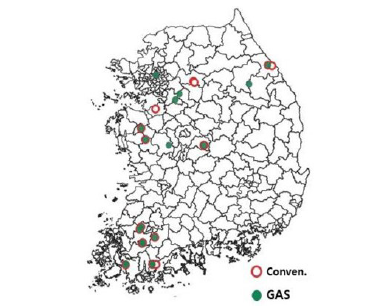Abstract
This study investigated the effects of conventional (CV) and golden apple snail (GAS) methods of weed control on weed occurrence in rice paddy levees (2021) and aquatic plant occurrence in rice paddies, agricultural waterways, and small streams (2022) in Gangwon, Gyeonggi, Chungnam, Chungbuk, Gwangju, and Jeonnam provinces at the transplanting, booting and harvesting stages of rice cultivation. In 2021, weed occurrence in rice paddy levees was highest at the transplanting stage, lower at the booting stage and lowest at harvest. This finding was consistent across all locations, regardless of weed control method. In areas where GAS methods were used, the most dominant weeds were Digitaria ciliaris, Artemisia princeps and Bidens frondosa. In total, 85 weed species were observed. The top 10 weed species were similar across all areas using both weed control methods. However, in areas where CV methods were used, only 69 weed species were observed. In general, Chungnam, Chungbuk and Jeonnam areas using GAS methods of weed control had greater weed diversity. Contrary to the levee surveys, 2022 studies in rice paddies, agricultural waterways, and streams found that the occurrence of aquatic plants was highest at harvest, lower at booting stages and lowest at the transplanting stages. Additionally, the number of aquatic plants was slightly higher in areas using GAS methods. The number of aquatic plants in rice paddies, agricultural waterways and streams was similar regardless of weed control methods, but aquatic plant diversity was higher in streams than in rice paddies and agricultural waterways. Therefore, the effects of GAS methods were more pronounced in levees where greater numbers of weed diversity were observed but did not significantly affect aquatic plant diversity in rice paddies, agricultural waterways, and streams.
Figures & Tables

Fig. 1 Investigation area treated with conventional (conven.) and golden apple snail (GAS) methods of weed control.


